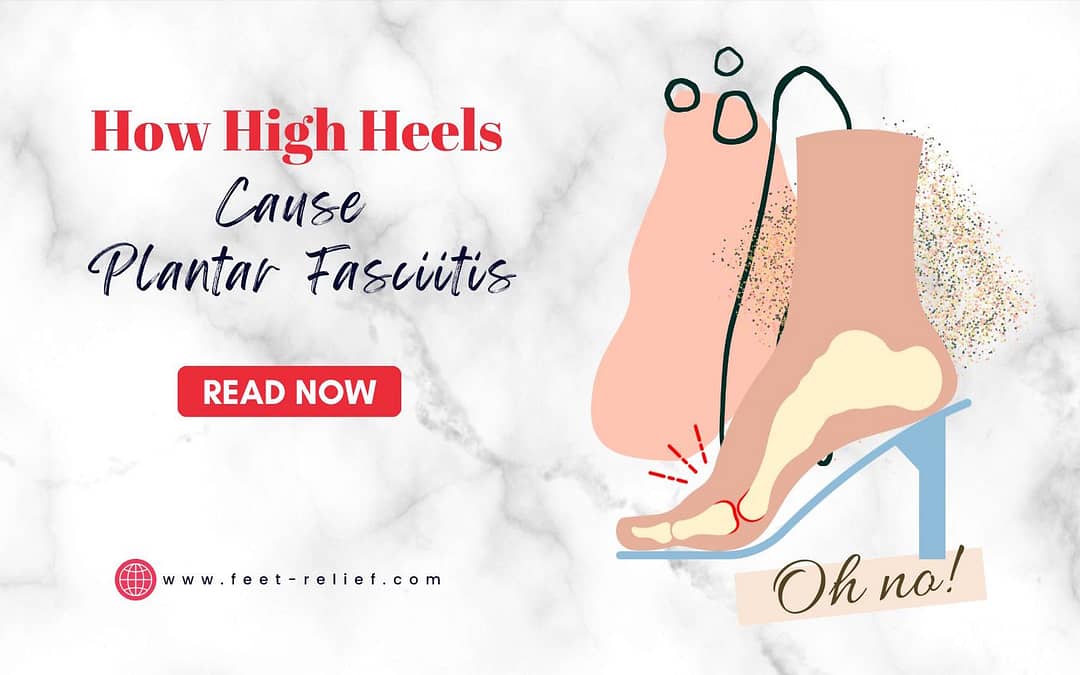Feet-Relief is supported by our audience. When you purchase through one of our links, we may earn a small affiliate commission. As an Amazon Associate I earn from qualifying purchases.Your cost is not affected.
How High Heels Cause Plantar Fasciitis, the pain of fashion
High heels are a fashion staple for many women, but they can also be a major cause of plantar fasciitis. Plantar fasciitis is a painful condition that affects the bottom of the foot. It is caused by inflammation of the plantar fascia, a thick band of tissue that runs along the bottom of the foot from the heel to the toes.
High heels can contribute to plantar fasciitis in a number of ways. First, they can increase the amount of stress on the plantar fascia. This is because high heels force the foot to assume an unnatural position, which puts more strain on the plantar fascia. Second, high heels can weaken the muscles in the foot. This is because high heels do not provide the same amount of support as flat shoes. As a result, the muscles in the foot have to work harder to keep the foot stable, which can lead to inflammation of the plantar fascia.
If you are experiencing pain in the bottom of your foot, it is important to see a doctor to rule out other causes of foot pain. If you are diagnosed with plantar fasciitis, there are a number of treatments available, including stretching, strengthening exercises, and orthotics. However, the best way to prevent plantar fasciitis is to avoid wearing high heels.
In this article, we will discuss how high heels cause plantar fasciitis and what you can do to prevent it. We will also provide some tips for managing plantar fasciitis if you already have it.
Understanding the Correlation: How High Heels Cause Plantar Fasciitis
Image Source: Unsplash
Introduction to Plantar Fasciitis
Let’s start with the basics – what exactly is plantar fasciitis? If you’ve ever experienced a stabbing pain in your heel when you take your first steps in the morning, you may have been suffering from plantar fasciitis. It’s a common orthopedic complaint, and the pain usually decreases as your foot limbers up, but it may return after long periods of standing or after sitting for extended periods.
Plantar fasciitis is an inflammation of the plantar fascia, a band of tissue that stretches across the bottom of your foot, from your heel bone to your toes. This condition can be caused by various factors, such as your weight, the type of shoes you wear, or the way you walk. However, one of the most common causes of plantar fasciitis is wearing high heels, which leads us to the main discussion of this article: How high heels cause plantar fasciitis.
Related: Plantar Fasciitis: Prevention and Treatment
The Anatomy of High Heels
High heels are a fashion staple for many women, known for their ability to elongate the legs and add a touch of elegance to any outfit. However, these stylish shoes can wreak havoc on the feet and body. To understand how high heels cause plantar fasciitis, it’s important to understand the anatomy of high heels and how they affect the body’s natural alignment.
When you wear high heels, your foot is held in an unnatural position, which places increased pressure on the front of the foot and the toes. This unnatural position can lead to a range of foot problems, including corns, bunions, and, of course, plantar fasciitis. The higher the heel, the greater the strain on the plantar fascia, which can lead to inflammation and pain.
How High Heels Cause Plantar Fasciitis
High heels not only force your feet into an unnatural position but also shift your body’s weight forward, causing you to adjust your body alignment to maintain balance. This unnatural alignment can cause strain on your lower back, hips, and knees, but it also places a tremendous amount of stress on your plantar fascia. When this stress becomes chronic, the plantar fascia can become inflamed and painful, leading to plantar fasciitis.
Scientifically, the unnatural position that high heels force your feet into can cause the plantar fascia to contract and shorten. Over time, this shortening can create tension on the fascia, leading to micro-tears. These micro-tears can cause inflammation and pain, which can worsen if not addressed properly.
Scientific Studies Supporting the Correlation
Several scientific studies support the correlation between wearing high heels and the development of plantar fasciitis. One study published in the Journal of Orthopaedic Science found that high heels can increase the strain on the plantar fascia by up to 15%. Another study in the Journal of the American Podiatric Medical Association found that women who regularly wear high heels have a higher incidence of plantar fasciitis.
These findings are not surprising, given the unnatural position and strain that high heels place on the foot. By understanding this correlation, you can make more informed decisions about your footwear choices and take steps to prevent or manage plantar fasciitis.
Related: Understanding Common Foot Problems
Symptoms of Plantar Fasciitis
Plantar fasciitis typically presents with a sharp, stabbing pain in the heel of the foot. This pain is usually worst in the morning when you take your first steps out of bed, or after you have been sitting or standing for a long time. You might also feel pain when you climb stairs or after intense activity.
If you notice these symptoms and you regularly wear high heels, it’s crucial to seek medical advice. Early intervention can prevent the condition from worsening and leading to other complications.
Long-Term Effects of Wearing High Heels
The long-term effects of wearing high heels go beyond plantar fasciitis. Regular use of high heels can cause changes in your posture, which can lead to a range of musculoskeletal issues, including lower back pain, knee pain, and even neck and shoulder problems.
In the context of plantar fasciitis, chronic inflammation and pain can lead to changes in your gait to alleviate the pain, which can result in other foot conditions such as bunions, hammertoes, and Achilles tendonitis.
Related: Foot Damage from High Heels
Prevention Strategies for Plantar Fasciitis
The good news is, plantar fasciitis is preventable, and the first step is to reconsider your footwear. Opting for shoes with lower heels, good arch support, and ample room for the toes can significantly reduce your risk of developing plantar fasciitis.
Another prevention strategy is regular stretching exercises, particularly for your calves and heels. This can help to maintain flexibility in your plantar fascia and reduce the tension that can lead to inflammation.
Treatment Options for Plantar Fasciitis
If you’re already suffering from plantar fasciitis, don’t despair. There are a range of treatment options available. Over-the-counter pain relievers, ice packs, and rest can help to reduce inflammation and pain in the short term.
In the long term, physical therapy and stretching exercises can strengthen the plantar fascia and other muscles of the foot, helping to prevent further damage. In more severe cases, your doctor may recommend orthotic devices or even surgery.
Alternatives to High Heels
If you love the look of high heels but hate the pain they can cause, there are alternatives. Wedge heels and platform shoes can provide the height you’re looking for without the drastic arch that high heels cause. Shoes with a wider heel base also provide more support and stability, reducing the strain on your plantar fascia.
In the end, your health should always take priority over fashion. There are plenty of stylish and comfortable options out there that won’t wreak havoc on your feet.
High Heels and Plantar Fasciitis
Understanding the correlation between high heels and plantar fasciitis is the first step in preventing this painful condition. While high heels may be fashionable, the pain and long-term damage they can cause are far from it. By making informed decisions about your footwear and taking steps to prevent and treat plantar fasciitis, you can keep your feet healthy and pain-free. After all, a strong foundation is key to a healthy life.
Amazon and the Amazon logo are trademarks of Amazon.com, Inc, or its affiliates.



